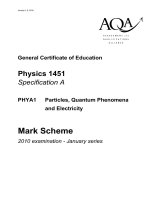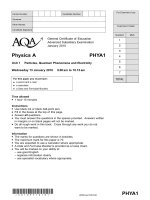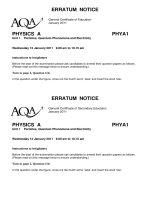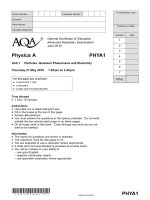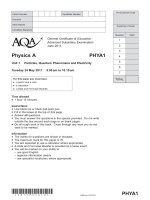- Trang chủ >>
- Khoa Học Tự Nhiên >>
- Vật lý
Vật lý A level:AQA PHYA1 QP JAN12
Bạn đang xem bản rút gọn của tài liệu. Xem và tải ngay bản đầy đủ của tài liệu tại đây (382.61 KB, 12 trang )
(JAN12PHYA101)
WMP/Jan12/PHYA1
PHYA1
Centre Number
Surname
Other Names
Candidate Signature
Candidate Number
General Certificate of Education
Advanced Subsidiary Examination
January 2012
Time allowed
l
1 hour 15 minutes
Instructions
l
Use black ink or black ball-point pen.
l
Fill in the boxes at the top of this page.
l
Answer all questions.
l
You must answer the questions in the spaces provided. Do not write
outside the box around each page or on blank pages.
l
Do all rough work in this book. Cross through any work you do not
want to be marked.
l
Show all your working.
Information
l
The marks for questions are shown in brackets.
l
The maximum mark for this paper is 70.
l
You are expected to use a calculator where appropriate.
l
A Data and Formulae Booklet is provided as a loose insert.
l
You will be marked on your ability to:
– use good English
– organise information clearly
– use specialist vocabulary where appropriate.
For this paper you must have:
l
a pencil and a ruler
l
a calculator
l
a Data and Formulae Booklet (enclosed).
Physics A PHYA1
Unit 1 Particles, Quantum Phenomena and Electricity
Thursday 12 January 2012 1.30 pm to 2.45 pm
MarkQuestion
For Examiner’s Use
Examiner’s Initials
TOTAL
1
2
3
4
5
6
7
WMP/Jan12/PHYA1
Do not write
outside the
box
Answer all questions in the spaces provided.
1 (a) The table gives information about some fundamental particles.
Complete the table by filling in the missing information.
(7 marks)
1 (b) Each of the particles in the table has an antiparticle.
1 (b) (i) Give one example of a baryon particle and its corresponding antiparticle.
particle
antiparticle
(1 mark)
1 (b) (ii) State the quark structure of an antibaryon.
(1 mark)
1 (b) (iii) Give one property of an antiparticle that is the same for its corresponding particle and
one property that is different.
Same
Different
(2 marks)
(02)
2
11
particle quark
structure
charge strangeness baryon
number
uud 0
Sigma
+
uus + 1
ud 0 0
WMP/Jan12/PHYA1
Tur n over
ᮣ
(03)
Do not write
outside the
box
2 (a) State what is meant by the specific charge of a nucleus and give an appropriate unit for
this quantity.
unit:
(2 marks)
2 (b) Nucleus X has the same nucleon number as nucleus Y. The specific charge of X is
1.25 times greater than that of Y.
2 (b) (i) Explain, in terms of protons and neutrons, why the specific charge of X is greater than
that of Y.
(2 marks)
2 (b) (ii) Nucleus X is B. Deduce the number of protons and the number of neutrons in
nucleus Y.
number of protons
number of neutrons
(4 marks)
3
8
10
5
WMP/Jan12/PHYA1
Do not write
outside the
box
4
(04)
3 (a) Pair production can occur when a photon interacts with matter. Explain the process of
pair production.
(2 marks)
3 (b) Explain why pair production cannot take place if the frequency of the photon is below a
certain value.
(3 marks)
3 (c) Energy and momentum are conserved during pair production. State two other quantities
that must also be conserved.
(2 marks)
7
WMP/Jan12/PHYA1
Do not write
outside the
box
5
Tur n over
ᮣ
(05)
4 (a) When free electrons collide with atoms in their ground state, the atoms can be excited
or ionised.
4 (a) (i) State what is meant by ground state.
(1 mark)
4 (a) (ii) Explain the difference between excitation and ionisation.
(3 marks)
4 (b) An atom can also become excited by the absorption of photons. Explain why only
photons of certain frequencies cause excitation in a particular atom.
(4 marks)
Question 4 continues on the next page
WMP/Jan12/PHYA1
Do not write
outside the
box
6
(06)
4 (c) The ionisation energy of hydrogen is 13.6 eV. Calculate the minimum frequency
necessary for a photon to cause the ionisation of a hydrogen atom. Give your answer to
an appropriate number of significant figures.
answer Hz
(4 marks)
5 (a) A student is given a piece of metal wire and asked to investigate how the resistance of
the wire changes between a temperature of 0
o
C and 100
o
C.
5 (a) (i) Draw a labelled diagram of a suitable arrangement that would enable the student to
carry out the experiment.
(3 marks)
12
WMP/Jan12/PHYA1
(07)
Do not write
outside the
box
7
Tur n over
ᮣ
5 (a) (ii) Describe the procedure the student would follow in order to obtain accurate and reliable
measurements of the resistance of the wire at different temperatures between
0
o
C and 100
o
C.
The quality of written communication will be assessed in your answer.
(6 marks)
Question 5 continues on the next page
WMP/Jan12/PHYA1
8
(08)
5 (b) A certain metal has a critical temperature of –268
o
C (5 K). Explain what is meant by
critical temperature.
(2 marks)
6Xand Y are two lamps. X is rated at 12 V 36 W and Y at 4.5 V 2.0 W.
6 (a) Calculate the current in each lamp when it is operated at its correct working voltage.
X A
Y A
(2 marks)
6 (b) The two lamps are connected in the circuit shown in Figure 1. The battery has an emf
of 24 V and negligible internal resistance. The resistors, R
1
and R
2
are chosen so that
the lamps are operating at their correct working voltage.
Figure 1
11
R
1
24 V
V
R
2
Y
X
Do not write
outside the
box
WMP/Jan12/PHYA1
Do not write
outside the
box
6 (b) (i) Calculate the pd across R
1
.
answer V
(1 mark)
6 (b) (ii) Calculate the current in R
1
.
answer A
(1 mark)
6 (b) (iii) Calculate the resistance of R
1
.
answer Ω
(1 mark)
6 (b) (iv) Calculate the pd across R
2
.
answer V
(1 mark)
6 (b) (v) Calculate the resistance of R
2
.
answer Ω
(1 mark)
Question 6 continues on the next page
9
Tur n over
ᮣ
(09)
WMP/Jan12/PHYA1
Do not write
outside the
box
(10)
10
6 (c) The filament of the lamp in X breaks and the lamp no longer conducts. It is observed
that the voltmeter reading decreases and lamp Y glows more brightly.
6 (c) (i) Explain without calculation why the voltmeter reading decreases.
(2 marks)
6 (c) (ii) Explain without calculation why the lamp Y glows more brightly.
(2 marks)
7 A battery of emf 9.0 V and internal resistance, r, is connected in the circuit shown in
Figure 2.
Figure 2
11
2.0 Ω
9.0
V
6.0
Ω
BA
2.0
Ω
r
WMP/Jan12/PHYA1
Do not write
outside the
box
7 (a) The current in the battery is 1.0 A.
7 (a) (i) Calculate the pd between points A and B in the circuit.
answer = V
(2 marks)
7 (a) (ii) Calculate the internal resistance, r.
answer = Ω
(2 marks)
7 (a) (iii) Calculate the total energy transformed by the battery in 5.0 minutes.
answer = J
(2 marks)
7 (a) (iv) Calculate the percentage of the energy calculated in part (iii) that is dissipated in the
battery in 5.0 minutes.
answer %
(2 marks)
Question 7 continues on the next page
11
(11)
Tur n over
ᮣ
WMP/Jan12/PHYA1
Do not write
outside the
box
7 (b) State and explain one reason why it is an advantage for a rechargeable battery to have a
low internal resistance.
(2 marks)
END OF QUESTIONS
12
(12)
10
Copyright © 2012 AQA and its licensors. All rights reserved.

